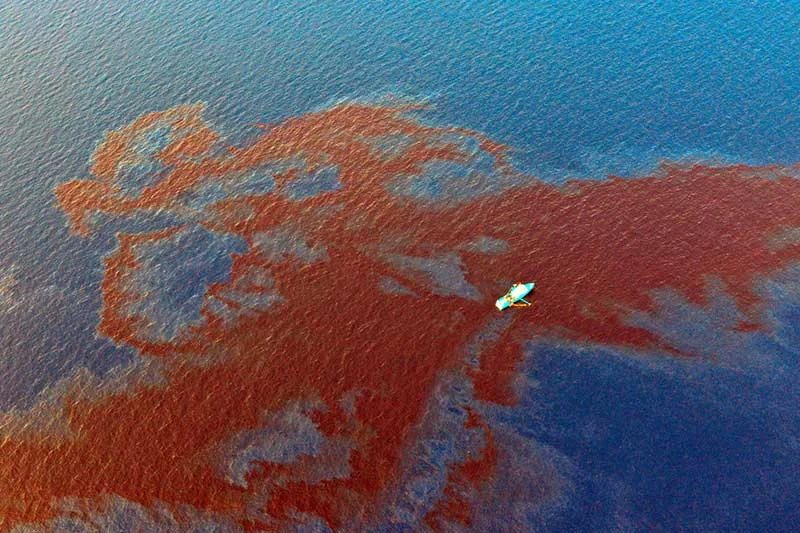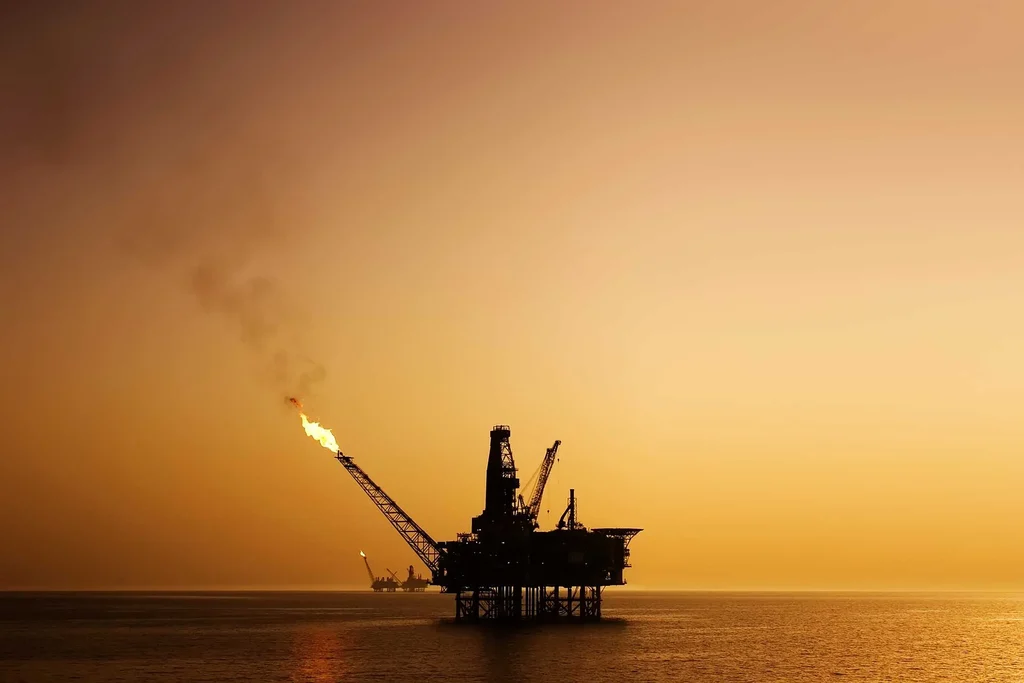A spill or accident at Woodside’s Burrup Hub gas project could release toxic gas and condensate of a similar consistency to crude oil into World Heritage listed marine parks, with dangerous pollution reaching West Australian coastal communities and as far as Indonesia
Woodside Energy’s Burrup Hub is the largest fossil fuel project currently proposed in Australia, involving the extraction of six untapped gas fields and the drilling of 84 wells off the Western Australian coast. The Burrup Hub project includes two major gas projects – Scarborough and Browse – and the transport of this gas onshore via undersea trunklines ranging between 430km (Scarborough) and 900km (Browse) in length.
Using Woodside’s own documents provided to state and federal regulators, Greenpeace has mapped Woodside’s Burrup Hub offshore infrastructure and its spill and accident scenarios using Geographic Information Software (GIS) data. This mapping shows that Woodside’s proposed infrastructure runs directly through or adjacent to habitats critical to threatened and migratory species as well as coral reef ecosystems. It also shows, for the first time, the full geographic extent of a worst-case gas spill or other accident on protected marine ecosystems as well as the coastlines of Western Australia, East Timor and Indonesia. This is just one of the reasons that Greenpeace is calling on Woodside to walk away from its toxic gas project.
Explore the map
Greenpeace has mapped Woodside’s Burrup Hub offshore infrastructure and its spill and accident scenarios using Geographic Information Software (GIS) data, based on Woodside’s own documents provided to state and federal regulators.
Woodside is hurtling towards an environmental disaster, and we have to act now

A spill or accident could release toxic gas and condensate into World Heritage listed marine parks, with dangerous pollution reaching West Australian coastal communities and as far as Indonesia.

The project is a risk to Western Australia’s beautiful and unique marine environments, and poses a direct threat to vulnerable coral ecosystems already impacted by climate change, as well as endangered turtle populations.

Woodside has a track record of accidents, degrading infrastructure and a haphazard approach to mitigating the impact of offshore infrastructure on marine environments, heightening the risk.
Woodside can’t be trusted
A history of Woodside and BHP’s accidents and serious incidents
50 km north-west of Exmouth, WA, an equipment failure caused a 500kg load to fall, seriously injuring two workers on Woodside’s Ngujima-Yin oil vessel.
Despite notifying NOPSEMA of one injured worker who was pinned under the fallen equipment, Woodside failed to notify the regulator of a second worker who was knocked unconscious by a falling chain block. At least one of the workers had to be transferred onshore for medical treatment.
Major corrosion issues were identified on a gas-train at the North West Shelf (NWS) project’s Karratha Gas Plant, wherein pipe walls had corroded to half their original thickness.
Areas of propane pipework found to have corroded to half their original wall thickness prompting concerns that corrosion might be more widespread at the plant. Similar corrosion related issues have presented other operators with serious issues in the past; one such example being the massive Varanus Island explosion at the Apache Energy plant.
NOPSEMA issued Woodside with a notice to analyse the structural integrity of fourteen 24-ton caissons, which were found to be corroding, located beneath its North Rankin A Platform.
If one of the corroded caissons were to break off and fall into the ocean below rupturing a trunkline, the “loss of hydrocarbon (gas and condensate) from these pipelines may result in a major accident event,” according to NOPSEMA. Woodside’s own operations plan stated that, “structural damage to the platform resulting from the causes listed… could be minor or could in the most extreme situation result in total loss of the platform”.
A 3-second ‘flash-fire’ burnt a worker’s hands and arms on Esso’s Kingfish B platform 90 kilometres off the coast of Lakes Entrance on April 26.
An investigation by NOPSEMA into the accident concluded that a series of failures led to the worker being hurt; further, the head of NOPSEMA’s safety and integrity division further noted that employees were nervous about voicing safety concerns on the rig for fear of losing their jobs.
After ceasing operations on their Echo Yodel project, Woodside left 400-tons of plastic umbilical and pipeline coating from their Echo Yodel project on the seafloor, 140 km off the coast of Dampier, WA.
Claiming that the plastic would take centuries to break-down, and thus the environmental impact would be low, Woodside suggested they be allowed to leave the plastic where it lay. NOPSEMA denied their request. Woodside would have allegedly also saved $160 million in further costs.
Woodside sold on its ageing Northern Endeavor floating oil platform, drawing widespread condemnation from industry and government. The decommissioning costs for the platform totalled over $1 billion, paid for by the government after liquidation of Northern Oil and Gas Australia (NOGA).
Beginning in February 2020, and still ongoing today – the saga of the Northern Endeavour remains a serious problem for Woodside. In 2020 following the liquidation of Northern Oil and Gas Australia (NOGA), the company handed over their largest asset, The Northern Endeavour floating oil platform to the Australian Government. Having sold the ageing Northern Endeavour to NOGA 4 years prior in a deal that drew widespread condemnation from industry, government, and society, a large part of the blame was directed at Woodside. Further, a lack of required government oversight, meant Woodside may have strategically jettisoned the asset for profit unto an unsuspecting small-time operator that was unable to afford maintenance and running costs.
Following NOGA’s liquidation, the decommissioning costs for the platform were estimated at $1 billion. After taking possession of the vessel, fears arose that the government, and by extension tax-payers, would be left to shoulder this colossal cost. Although tax-payers and the government have escaped footing the bill for the Northern Endeavour, it is unclear who exactly will bear the full cost to decommission it.
Woodside’s allowed its 83-metre-long Nganhurra Riser Turret Mooring (RTM) to become heavily degraded and then suggested sinking the infrastructure, containing highly toxic materials, in Ningaloo Reef.
NOPSEMA considered legal action against Woodside due to the state of the RTM. Following NOPSEMA’s notice, Woodside began preparing the RTM for disposal, but assessed the structure as too heavily degraded to be safely towed away; suggesting instead last year that they be allowed to sink the structure containing highly toxic materials near the Ningaloo Marine Park to create an artificial reef. While further proposing they host a ‘beach clean-up’ as part of a program to offset the dumped plastic contained in the structure, Woodside seemed keen to preserve their public optics while pursuing a cheap and easy way to deal with their neglected and highly hazardous RTM.
45 km off the Gippsland coast in Victoria, the joint-venture West-Tuna platform in the Bass Strait spills an unknown amount of oil, posing a “significant threat to the environment” according to a NOPSEMA investigator.
A NOPSEMA investigation concludes that the BHP-ExxonMobil spill response posed a “significant threat to the environment.” And, further added that due to a lack of equipment and training, staff were unable to locate the source of the spill.
Cossack Field in the Timor Sea, 125 km off the coast of WA, 10,500 litres of oil leaked over a two month period from an unnamed Woodside rig in the Cossack Field.
An unnamed rig in Woodside Petroleum’s Cossack Field on the North West Shelf leaks over a 2 month period between February and April. Over this period, 10,500 litres of oil leaks unnoticed into the ocean somewhere in Woodside’s Cossack Field. A spokesperson for Woodside claimed there was “no lasting impact to the environment”.
45 km off Victoria’s Gippsland coast in the Bass Strait at 1am a fire ignited in the West-Tuna platform’s battery storage room, raging out of control for 9 hours.
Completely shutting down power to the platform, a night time helicopter evacuation was carried out in complete darkness. The fire raged out of control for 9-hours, and was fought by some workers who stayed behind. The Australian Workers Union Victorian secretary, Ben Davis, said the oil rig fire raised questions about Esso’s equipment maintenance program, one that had been pared-back prior to the fire.
70 kilometres off the eastern Victorian coast, on BHP & ExxonMobil’s joint venture ‘Cobia’ platform, 750-litres of oil leaked into the sea.
The leak from the 30 year old rig, one of many pieces of ageing infrastructure used in the Bass Strait, was subsequently investigated by NOPSEMA.
Help stop Woodside’s Burrup Hub gas project
Australia is ready for a clean energy future. But as the rest of the world charges ahead, Woodside wants to drill for climate-wrecking gas in Western Australia’s pristine oceans – threatening species like whales, turtles, and coral reefs.
By donating regularly you can help power our campaigns to stop polluters like Woodside.
Make a tax-deductible donation to help save marine life today.


